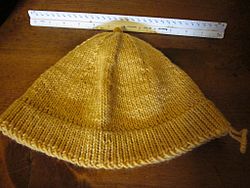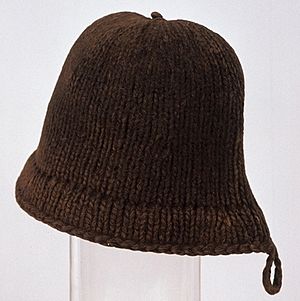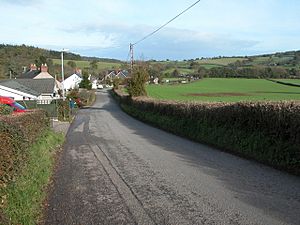Monmouth cap facts for kids

An example of a Monmouth cap
|
|
| Type | Hat |
|---|---|
| Material | Wool |
| Place of origin | Monmouth, Wales |
The Monmouth cap (called Cap Trefynwy in Welsh) was a type of woollen hat. It was very popular between the 1400s and 1700s. This special knitted cap is linked to the town of Monmouth in South East Wales. Both soldiers and sailors wore these round caps, and they were sold all over the world.
Contents
A Look Back in Time: History of the Cap
Where Did They Come From?
In the early 1300s, the area just north of Monmouth, called Archenfield, was famous for its amazing wool. This wool came from Ryeland sheep. It was perfect for making high-quality felt. Monmouth was also located on the River Wye, which made it easy to send goods to bigger markets.
By the 1400s, making caps by hand was a big business in Monmouth. Old records show that "Capper" (meaning cap-maker) was a common last name there. These cap-makers were usually men. They were part of the Weaver's Guild, a group of skilled workers. The cap-making trade was especially strong in the Overmonnow area, sometimes called "Cappers' town." However, some old stories say that the trade later moved to Bewdley because of an outbreak of plague in Monmouth.
Why Were They So Popular?
Monmouth caps were worn by people from all walks of life in England, from the rich to the poor. They were most popular in the 1400s and 1500s. These caps were a must-have for soldiers, sailors, and workers. They were so common that people just expected to see them. One old book from the 1800s said that at one time, a huge number of people in England and Wales wore them.
To protect local cap makers, a law was made in 1488. It said people in England and Wales could not wear caps made in other countries. Later, in 1571, during the time of Elizabeth I, another law was passed. It said that almost everyone over six years old had to wear a wool cap made in England on Sundays and holidays. This law was meant to help English cap makers, as new types of hats were becoming popular. But the law was hard to enforce, so it was canceled in 1597.
Famous Wearers and Mentions
The first time we see the name "Monmouth Cappe" in writing was in 1576. It was in a letter from Lord Gilbert Talbot to his father, sent with a cap as a New Year's gift. This shows the caps were well-known and even given as gifts between important people.
King Henry V was born in Monmouth. The cap is even mentioned in Shakespeare's play, Henry V, written around 1599. In the play, a character named Fluellen says:
Fluellen: "Your majesty says very true: if your majestie is remembered of it, the Welshmen did good service in a garden where leeks did grow, wearing leeks in their Monmouth caps; which, your majesty knows, to this hour is an honourable badge of the service; and I do believe your majesty takes no scorn to wear the leek upon Saint Davy's day."
In the 1620s, the people setting up the Massachusetts Bay Colony in America ordered Monmouth caps for their settlers. These caps were described as "thick, warm, fulled by hand- and foot- beating and much favored by seamen." Daniel Defoe, a famous writer, wrote in 1712 that Dutch sailors often wore Monmouth caps. Even Peter the Great of Russia wore one in 1697 when he worked for the East India Company. His cap is now kept in the Hermitage Museum in Saint Petersburg.
Over time, more and more Monmouth caps were made outside of Monmouthshire. So, the name "Monmouth cap" began to mean the style of the cap, not where it was made. Other places made similar caps, and they were also called knitted caps, Kilmarnock cauls, Scotch bonnets, or watch caps.
How Were Monmouth Caps Made?
The Design and Materials

The oldest Monmouth cap we still have is at Monmouth Museum. It was knitted from rough, two-ply wool. The cap was started at the bottom edge and knitted in a circle towards the top. The top of the cap was rounded, and the last stitches were tied off. The leftover yarn was wrapped around the top to gather it, making a small bump. The brim (the edge around the bottom) was made by picking up stitches inside the cap and knitting downwards.
Making Them Weatherproof
Each hat was made to be waterproof by a process called felting. This process made the wool fibers shrink and become very dense, making the cap smaller and stronger. The oldest cap we have is about 5 to 6 inches from the center to the edge.
Thousands of Monmouth caps were made. But because they were not very expensive and the knitting could easily come apart, very few of them still exist today.
Bringing the Past to Life: Reproductions
Today, people make similar caps for historical reenactment groups. These groups try to recreate history, and they need accurate clothing.
Sometimes, when people try to knit an exact copy, the cap ends up a bit too narrow after felting. This is because modern knitting yarns felt differently than the old ones.
The Cap's Lasting Mark
There was once a famous inn called the Monmouth Cap Inn. It was a place where coaches would stop on the main road between Abergavenny and Hereford, near Llangua on the River Monnow. This river was the border between Herefordshire and Monmouthshire. Even though the inn is now closed, the name "Monmouth Cap" is still used for that area today.
See also
- Tuque
- Blue bonnet (hat)


